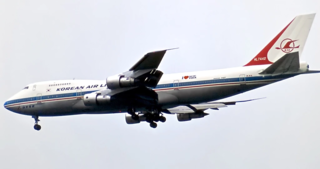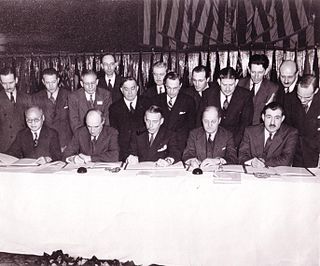
General aviation (GA) is defined by the International Civil Aviation Organization (ICAO) as all civil aviation aircraft operations except for commercial air transport or aerial work, which is defined as specialized aviation services for other purposes. However, for statistical purposes, ICAO uses a definition of general aviation which includes aerial work.

The International Civil Aviation Organization is a specialized agency of the United Nations that coordinates the principles and techniques of international air navigation, and fosters the planning and development of international air transport to ensure safe and orderly growth. The ICAO headquarters are located in the Quartier international de Montréal of Montreal, Quebec, Canada.

International Mobile Satellite Organization (IMSO) is the oversight body of the satellite communications elements of the Global Maritime Distress and Safety System (GMDSS) established by the IMO designed to provide a worldwide system for automated emergency signal communication for ships at sea. IMSO ensures that the provision of maritime mobile satellite communications services (currently provided by Inmarsat Ltd and Iridium Ltd).

The (International) Radiotelephony Spelling Alphabet, commonly known as the NATO phonetic alphabet, is the most widely used set of clear code words for communicating the letters of the Roman alphabet. Technically a radiotelephonic spelling alphabet, it goes by various names, including NATO spelling alphabet, ICAO phonetic alphabet and ICAO spelling alphabet. The ITU phonetic alphabet and figure code is a rarely used variant that differs in the code words for digits.

Korean Air Lines Flight 007 (KE007/KAL007) was a scheduled Korean Air Lines flight from New York City to Seoul via Anchorage, Alaska. On September 1, 1983, the flight was shot down by a Soviet Sukhoi Su-15 interceptor aircraft. The Boeing 747 airliner was en route from Anchorage to Seoul, but owing to a navigational mistake made by the crew, the airliner drifted from its original planned route and flew through Soviet prohibited airspace. The Soviet Air Forces treated the unidentified aircraft as an intruding U.S. spy plane, and destroyed it with air-to-air missiles, after firing warning shots. The Korean airliner eventually crashed into the sea near Moneron Island west of Sakhalin in the Sea of Japan, killing all 269 passengers and crew aboard, including Larry McDonald, a United States representative. The Soviet Union found the wreckage under the sea two weeks later on September 15 and found the flight recorders in October, but this information was kept secret by the Soviet authorities until 1992, after the country's collapse.

An aviation accident is defined by the Convention on International Civil Aviation Annex 13 as an occurrence associated with the operation of an aircraft, which takes place from the time any person boards the aircraft with the intention of flight until all such persons have disembarked, and in which (a) a person is fatally or seriously injured, (b) the aircraft sustains significant damage or structural failure, or (c) the aircraft goes missing or becomes completely inaccessible. Annex 13 defines an aviation incident as an occurrence, other than an accident, associated with the operation of an aircraft that affects or could affect the safety of operation.

The United Nations System consists of the United Nations' six principal bodies, the Specialized Agencies and related organizations. The UN System includes subsidiary bodies such as the separately administered funds and programmes, research and training institutes, and other subsidiary entities. Some of these organizations predate the founding of the United Nations in 1945 and were inherited after the dissolution of the League of Nations.

METAR is a format for reporting weather information. A METAR weather report is predominantly used by aircraft pilots, and by meteorologists, who use aggregated METAR information to assist in weather forecasting. Today, according to the advancement of technology in civil aviation, the METAR is sent as IWXXM model.

The Convention on International Civil Aviation, also known as the Chicago Convention, established the International Civil Aviation Organization (ICAO), a specialized agency of the United Nations charged with coordinating international air travel. The Convention establishes rules of airspace, aircraft registration and safety, security, and sustainability, and details the rights of the signatories in relation to air travel. The convention also contains provisions pertaining to taxation.
Aviation law is the branch of law that concerns flight, air travel, and associated legal and business concerns. Some of its area of concern overlaps that of admiralty law and, in many cases, aviation law is considered a matter of international law due to the nature of air travel. However, the business aspects of airlines and their regulation also fall under aviation law. In the international realm, the International Civil Aviation Organization (ICAO) provides general rules and mediates international concerns to an extent regarding aviation law. The ICAO is a specialized agency of the United Nations.
The Philippine National Police Aviation Security Group (PNP-AVSEGROUP) is responsible for enforcing laws and regulations related to air travel in the Philippines.
The following outline is provided as an overview of and topical guide to the United Nations:

Civil aviation is one of two major categories of flying, representing all non-military and non-state aviation, both private and commercial. Most countries in the world are members of the International Civil Aviation Organization and work together to establish common Standards and Recommended Practices for civil aviation through that agency.

Pilot Point Airport is a state-owned, public-use airport located in Pilot Point, a city in the Lake and Peninsula Borough of the U.S. state of Alaska. Scheduled airline service to King Salmon Airport is provided by Grant Aviation.

Harold Olusegun Demuren is a Nigerian aeronautical engineer. He was Director General of the Nigerian Civil Aviation Authority from December 2005 to March 2013.

On 24 February 1996 a Cuban Air Force Mikoyan MiG-29UB shot down two unarmed Cessna 337 Skymaster aircraft operated by Brothers to the Rescue, an organization opposed to the Cuban government. The Organisation of American States (OAS) reported that no warning was given; Cuban government sources said "These people knew what they were doing. They were warned", and that the aircraft had entered Cuban airspace. All the occupants of the aircraft were killed: Carlos Costa, Armando Alejandre, Jr., Mario de la Peña, and Pablo Morales. A third Cessna involved escaped. Previous similar flights had released propaganda leaflets over Cuba.

The permanent representative of Australia to the International Civil Aviation Organization is an officer of the Australian Department of Infrastructure, Transport, Regional Development, Communications and the Arts and the head of the delegation of the Commonwealth of Australia to the Council of the International Civil Aviation Organization (ICAO) in Montreal, Canada. The position has the rank and status of an ambassador extraordinary and plenipotentiary and is one of Australia's representatives to the United Nations and its other constituent agencies. The Australian nominee to the Air Navigation Commission, a body that works towards the uniformity in regulations, standards and procedures which will facilitate and improve air navigation to international standards, acts as the deputy to the Permanent Representative.














